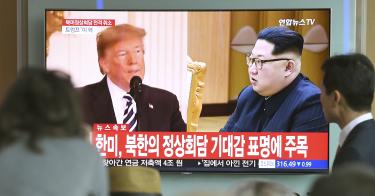President Trump and South Korean President Moon Jae-in are slated to meet on the sidelines of the UN General Assembly today to discuss next steps regarding North Korea. Moon just concluded the third inter-Korean summit, where he and Kim Jong-un inked the Pyongyang Declaration. Moon likely brings word about the future direction of stalled U.S. negotiations over North Korean denuclearization.
Moon is expected to reiterate Kim’s desire for a Trump-Kim summit 2.0, a follow-on meeting to the June 12 Singapore summit—the first-ever meeting between a sitting U.S. President and a North Korean leader. Analysts also anticipate that Moon will convey, approvingly, Kim’s request that the U.S. sign a peace declaration.
A second summit and a peace declaration, at this time, would be a mistake.
Since the Singapore summit, Kim has not moved substantively toward denuclearization. Dismantlement of the Sohae missile test site and promises to dismantle the Yongbyon nuclear facility do nothing meaningful to rein in the North’s nuclear and missile programs. Rather than a sacrifice of significant capabilities, both actions are like a child getting rid of old toys to make room for new ones. A mere retirement of capabilities that are of little use to North Korea now that they have more advanced weapons capabilities.
Since Singapore, the U.S. and North Korea are no closer to achieving denuclearization than they were before. The Singapore communique was a weak document that was short on details, and what details there were included some terms that should be unacceptable. Take, for example, the definition of denuclearization. Complete denuclearization, to North Korea, means denuclearization of the entire Korean peninsula including U.S. stateside nuclear assets that serve as a nuclear umbrella to U.S. ally, South Korea. The U.S. and North Korea are no closer to agreeing to the UN legally-binding definition of denuclearization – complete, verifiable, irreversible dismantlement of North Korea’s nuclear program – than they were on June 11th.
These key terms need to be negotiated out. Yet thus far, North Korea refuses to cooperate with closed-door meetings led by Secretary Pompeo. Instead, they insist on negotiating with President Trump himself. This may be an attempt to create divisions within the administration. And it may be working. A few weeks ago, President Trump canceled a scheduled trip involving Secretary Pompeo and newly appointed Special Representative for North Korea Policy Stephen Biegun a mere 24 hours after it was announced.
Signing a peace declaration now has the potential to weaken the U.S. hand in nuclear negotiations with North Korea. As Heritage Foundation Senior Fellow for Northeast Asia Bruce Klingner argues, a peace declaration has the potential to harm alliance security, reduce U.S. troop presence on the Korean peninsula, and dampen efforts to increase pressure on North Korea.
Nor is it clear what would be gained by such a declaration. As Klingner points out:
The U.S. has already repeatedly provided non-hostility declarations and promises not to attack North Korea with either conventional or nuclear weapons. These documents had no impact on North Korea’s continued production of nuclear weapons.
Why would this piece of paper be expected to have greater impact than those previously provided pledges?
Rather than sign a peace declaration, the U.S. should coordinate closely with its South Korean ally to ensure that both countries “stay the course” with their maximum pressure strategy toward North Korea. The U.S. has still stopped short of so-called maximum pressure. For example, it has not yet designated a single Chinese bank for the role it plays in laundering money for the Kim regime’s rogue missile and nuclear weapons programs.
New promises made by President Moon on his last trip to Pyongyang technically violate UN and U.S. sanctions toward North Korea, and are promises South Korea will be hard-pressed to keep. Of particular concern is Moon’s promise to support the reopening of the Kaesong Industrial Complex. Also troubling is Moon’s suggestion that South Korea will support the development of an east-west railway link.
A small ask prior to agreeing to a second summit or signing a peace declaration would be for the U.S. and South Korea to request that North Korea permit inspections of its nuclear facilities by outside nuclear experts, or that the regime make a full data declaration of its current capabilities.
Negotiations, by their nature, must involve give-and-take. But a second summit now promises to produce nothing but another photo-op and a second chance for the human rights-abusing and nuclear-weapons wielding Kim to sanitize his image. And a peace declaration today, with so little changed since the Singapore summit, would sacrifice too much leverage too soon for little promise of a return on investment.
President Trump should be wary of either proposal.
This piece originally appeared in Forbes https://www.forbes.com/sites/oliviaenos/2018/09/24/why-president-trump-should-say-no-to-a-trump-kim-summit-2-0/#441429695615



